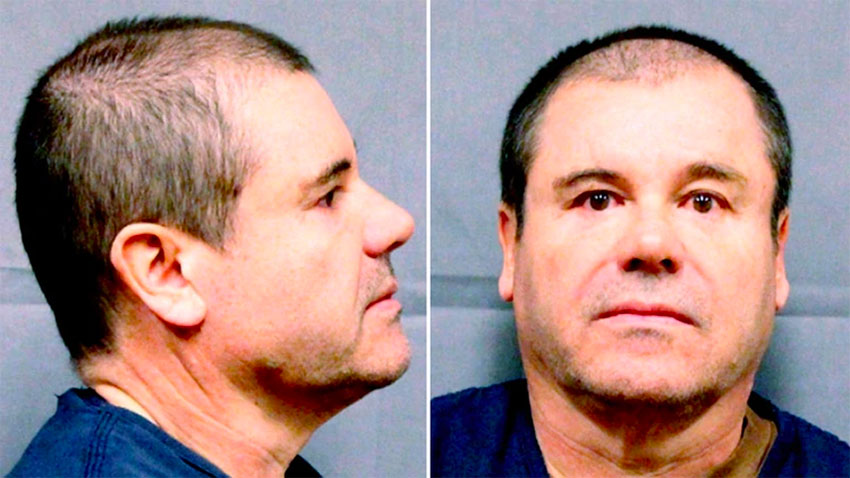Mexico’s most famous drug lord, already renowned for building one escape tunnel, was planning another three years ago in a bid to make a third escape from jail after he was captured in January 2016.
Nuevo León prison official Eduardo Guerrero Durán told the state news agency Notimex that a second tunnel was found at the Altiplano federal prison in México state, where the former leader of the Sinaloa Cartel was incarcerated following his arrest on January 8, 2016 in Los Mochis, Sinaloa.
Six months earlier, “El Chapo” had escaped from the same prison via a 1.6-kilometer-long tunnel that led to the bathroom in his cell.
Guerrero said that after the second tunnel was discovered, Guzmán – who was entenced in a New York court yesterday to life imprisonment – was transferred to a penitentiary in Ciudad Juárez, Chihuahua, before he was extradited to the United States in January 2017.
The tunnel was detected after prison staff noticed noises emanating from Guzmán’s bathroom, to which the notorious drug lord went frequently, the official explained.
While in the bathroom, Guzmán would repeatedly flush the toilet.
As a result of the noises and suspicious behavior, a study of the soil beneath the prison was carried out and the second tunnel was found.
There was also a reference during Guzmán’s trial of his wish to make another prison escape after his 2016 capture.
Dámaso López, a former Sinaloa Cartel leader who was previously a security chief at the Jalisco prison from which “El Chapo” escaped in 2001, testified that Guzmán’s wife, Emma Coronel, approached him to discuss a third prison break.
“My comadre [female friend] sought me out to tell me that my compadre [buddy] wanted to escape again, [to ask] if I would help him again,” López told jurors.
It is unclear whether he was involved in planning the excavation of the second tunnel.

The witness – sentenced to life imprisonment in the United States last year on drug trafficking charges – also testified that he and other officials at the Puente Grande maximum security prison took bribes from Guzmán during his first incarceration in exchange for providing him with a range of perks such as new shoes, a mobile telephone and secret visits with his wife and other family members.
López quit his security job in September 2000 but told jurors that before he left he had a final meeting with Guzmán, who asked him to speak with the new security chief so that his perks would be preserved.
Four months later, the drug lord was wheeled out of the prison in a laundry cart and would remain a free, albeit wanted, man for the next 13 years.
Guzmán’s lengthy and notorious criminal career came to an official end yesterday when federal Judge Brian Cogan imposed a mandatory sentence of life imprisonment plus 30 years. He was found guilty on 10 drug trafficking charges in February.
United States authorities have not yet made any formal announcement but Guzmán is likely to spend the rest of his life at the “Supermax” prison in Florence, Colorado, the country’s most secure penitentiary where tunneling out might be a challenge.
According to a report in the New York Post, he was on his way to the facility Wednesday night.

Since it opened in 1994, no one has ever escaped from the federal prison that is officially called United States Penitentiary, Administrative Maximum Facility.
Located 185 kilometers south of Denver and nicknamed “Alcatraz of the Rockies,” the prison is home to a who’s who of notorious criminals.
Among the 376 inmates are domestic terrorist Ted Kaczynski, known as the “Unabomber,” September 11 conspirator Zacarias Moussaoui, Oklahoma City bomber Terry Nichols, “shoe bomber” Richard Reid and Boston Marathon bomber Dzhokhar Tsarnaev.
Prisoners are typically confined to their solitary cells for 23 hours a day, where they may watch television or gaze out a narrow window that is angled upward so that only the sky is visible.
Special restrictions ensure inmates cannot make threats or exert influence in the outside world. Prisoners are escorted during all movements and head counts are done at least six times a day, the news agency Reuters reported.
“It’s very well designed for its purpose, to hold the most dangerous offenders in the federal prison system,” said Martin Horn, a professor at the John Jay College of Criminal Justice in New York and former commissioner of the city’s Department of Correction.
He told Reuters that the Florence “Supermax” prison “is literally built into the side of a mountain, with a robust security infrastructure.”
“Could Guzmán penetrate that?” Horn was asked.
“I would never say never,” he responded, “but it’s highly unlikely.”
Source: Notimex (sp), Infobae (sp), Reforma (sp), Reuters (en)
